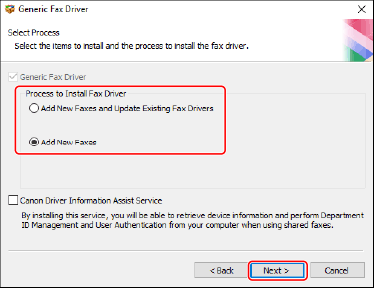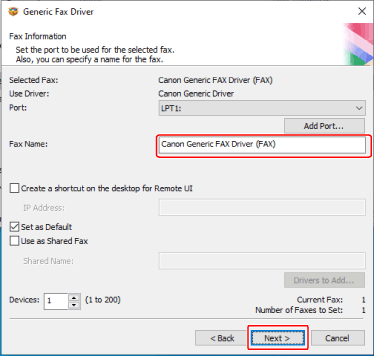Selecting [Custom] to Install
This explains the procedure for manually specifying the port to use for a network connection or local connection and installing the driver. As well as existing ports, you can add a standard TCP/IP port or network printer port.
Prerequisites
Confirm the port to be specified
Specify a standard TCP/IP port or a network printer port. You can specify an already registered port. You can select a temporary port ([LPT1] etc.) and set it after installation is complete.
Confirm the name and IP address of the device (if adding a standard TCP/IP port).
You must enter the device name and IP address when adding a standard TCP/IP port and installing. For the name of the device, use the name by which the device is known on the network. If you do not know the device name or IP address, check with your network administrator.
Confirm the queue specified for each port (if the target device is shown in the following).
If an optional external print server unit is attached to the target device, after selecting the port, you must specify the queue. Click "Open details," and confirm the queue corresponding to the selected port.
Specify the queues corresponding to the port.
For LPR:
For Windows TCP/IP, enter a Print, Hold, and Direct queue name in the [Queue Name] column.
For RAW:
The queue to be specified is determined by the port number.
9100: Print, Hold, or Direct
9101: Direct queue
9102: Print queue
9103: Hold queue
For SMB:
When you select the device from the network tree, three queues are displayed. Select one from among the displayed queues.
For NetWare:
Depending on the device you are using, turn the banner setting off.
When starting the computer, log on as a user with administrator privileges.
Procedures
1.
Start the installer.
If you are using an installer downloaded from the web site
Double-click the downloaded file to decompress it. If the installer does not start automatically after it is decompressed, double-click [Setup.exe].
If you are using the accompanying CD-ROM
(1) Set the CD-ROM in the computer.
If the CD-ROM menu is not displayed, click the subsequent "Open details."
Start the installer by following the procedure below.
If a message prompting you to insert a CD-ROM is displayed or if Windows Explorer is displayed: Execute [MInst.exe].
If nothing is displayed: Double-click the CD-ROM icon.
If the above [MInst.exe] does not exist: Execute [Setup.exe] in the driver folder of the CD-ROM.
If you executed [Setup.exe], proceed to step 2.
(2) If the language selection screen is displayed, select a language → click [OK].
(3) Click [Installation] from the menu screen.
(4) If the [Select the Type of Connection] screen is displayed, select [Network Connection] → click [Next].
(5) On the [Installation] screen, confirm that the fax driver is selected → click [Install].
(6) Confirm the content of the CANON SOFTWARE LICENSE AGREEMENT → click [Yes].
Select a language → click [Next].
3.
When the CANON SOFTWARE LICENSE AGREEMENT is displayed, confirm the content → click [Yes].
4.
Select [Custom] → click [Next].

5.
Select the required items → click [Next].
[Process to Install Fax Driver]: Select this if necessary if a driver is already installed.
[Canon Driver Information Assist Service]: Select this when you want to use the device information retrieval function.

6.
Set the port.
Ports that can be specified if you are using a device that does not support NetWare or IPP are LPR, RAW, and SMB.
If you are using an existing port, select the port from [Port] → proceed to step 8. If you want to specify the port after installation, select a temporary port ([LPT1] etc.) → proceed to step 8.

7.
Click [Add Port] → select the type of port ([Standard TCP/IP Port], [WSD Port], or [Network]) from [Port to Add] → click [OK].
When adding a network printer port:
Select the network printer to use → click [OK] → proceed to step 8.
When adding a standard TCP/IP port:
Enter the device name or IP address according to the instructions of the wizard.
[Port Name] is automatically entered. Change the port name if required.
When adding a WSD port:
Enter the IP address or host name → click [OK] → proceed to step 8.
 NOTE
NOTEIf the [Additional port information required] screen is displayed, perform one of the following procedures.
Return to the previous screen in the wizard → re-enter the information in [Printer Name or IP Address] → click [Next].
Select [Standard] for [Device Type] → select [Canon Network Printing Device with P9100] → click [Next].
Depending on the device you are using, the type of device that you can select in the [Additional port information required] screen > [Device Type] > [Standard] may vary.
Change [Fax Name] if necessary → click [Next].
[Create a shortcut on the desktop for Remote UI]: Creates a shortcut to the Remote UI of the device on the desktop. Enter the IP address of the device in [IP Address].
To update the IP address of the device set in the shortcut after installing the driver, or delete the shortcut, do so manually.
[Set as Default]: Select this to set the device as the device that is normally used.
[Use as Shared Fax]: Select this if you want to configure shared settings for the device.
If you added or selected a network printer port, you cannot set [Fax Name] and [Use as Shared Fax].
[Devices]: If necessary, enter the number of devices to be installed.
When you click [Next], the [Fax Information] screen is repeatedly displayed for the number of devices specified. Configure the settings for each device.

9.
Check [Fax List for Driver Installation] → click [Start].
Proceed with the installation according to the instructions on the screen.
10.
Click [Restart] (or [Exit]).